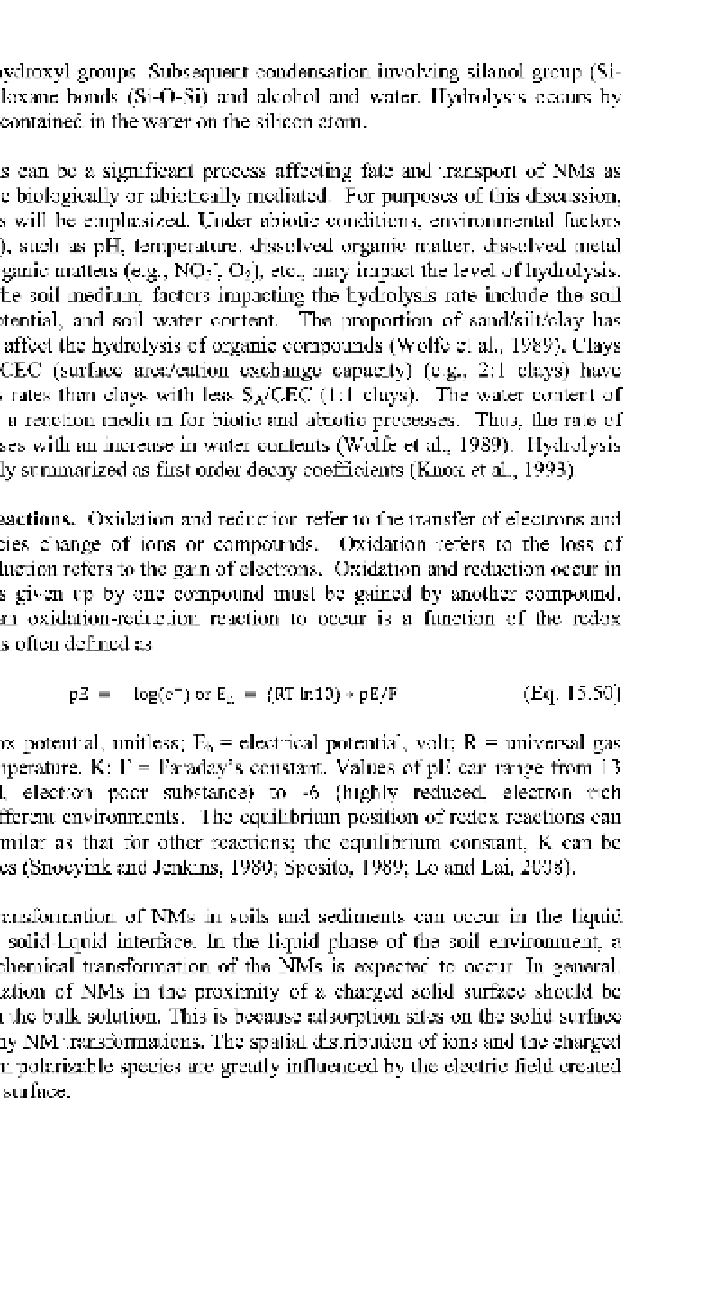Environmental Engineering Reference
In-Depth Information
are replaced by hydroxyl groups. Subsequent condensation involving silanol group (Si-
OH) produced siloxane bonds (Si-O-Si) and alcohol and water. Hydrolysis occurs by
attack of oxygen contained in the water on the silicon atom.
Hydrolysis can be a significant process affecting fate and transport of NMs as
hydrolysis may be biologically or abiotically mediated. For purposes of this discussion,
abiotic hydrolysis will be emphasized. Under abiotic conditions, environmental factors
(see Table 15.10), such as pH, temperature, dissolved organic matter, dissolved metal
ions or other inorganic matters (e.g., NOs", 02), etc., may impact the level of hydrolysis.
With respect to the soil medium, factors impacting the hydrolysis rate include the soil
type, sorption potential, and soil water content. The proportion of sand/silt/clay has
been observed to affect the hydrolysis of organic compounds (Wolfe et al., 1989). Clays
with greater SA/CEC (surface area/cation exchange capacity) (e.g., 2:1 clays) have
higher hydrolysis rates than clays with less SA/CEC (1:1 clays). The water content of
the soil serves as a reaction medium for biotic and abiotic processes. Thus, the rate of
hydrolysis increases with an increase in water contents (Wolfe et al., 1989). Hydrolysis
data are commonly summarized as first order decay coefficients (Knox et al., 1993).
Redox Reactions.
Oxidation and reduction refer to the transfer of electrons and
concomitant species change of ions or compounds. Oxidation refers to the loss of
electrons, and reduction refers to the gain of electrons. Oxidation and reduction occur in
tandem; electrons given up by one compound must be gained by another compound.
The ability for an oxidation-reduction reaction to occur is a function of the redox
potential, which is often defined as
pE = -log(e-)orE
h
= (RT InlO) * pE/F
(Eq. 15.50)
where pE = redox potential, unitless; Eh = electrical potential, volt; R = universal gas
constant; T = temperature, K; F = Faraday's constant. Values of pE can range from 13
(highly oxidized, electron poor substance) to -6 (highly reduced, electron rich
substances) in different environments. The equilibrium position of redox reactions can
be determined similar as that for other reactions; the equilibrium constant, K can be
found in references (Snoeyink and Jenkins, 1980; Sposito, 1989; Lo and Lai, 2008).
Abiotic transformation of NMs in soils and sediments can occur in the liquid
phase and at the solid-liquid interface. In the liquid phase of the soil environment, a
large variety of chemical transformation of the NMs is expected to occur. In general,
abiotic transformation of NMs in the proximity of a charged solid surface should be
faster than that in the bulk solution. This is because adsorption sites on the solid surface
may catalyze many NM transformations. The spatial distribution of ions and the charged
distribution within polarizable species are greatly influenced by the electric field created
from the charged surface.

Search WWH ::

Custom Search